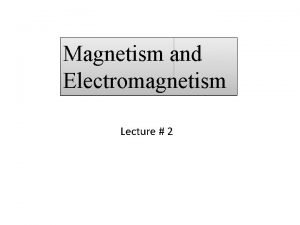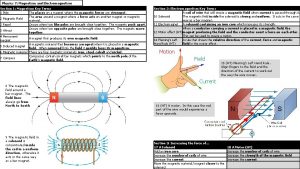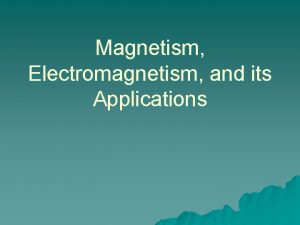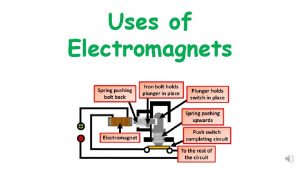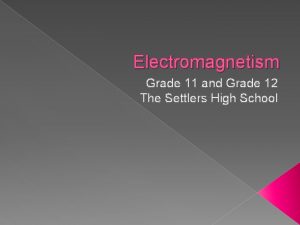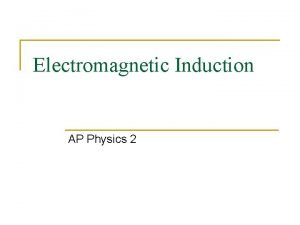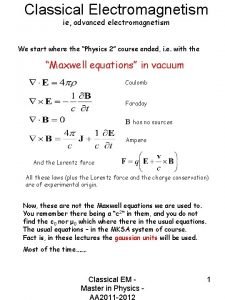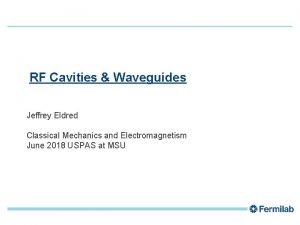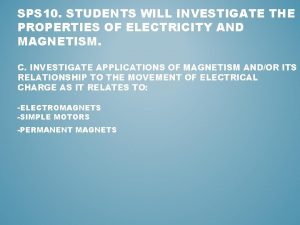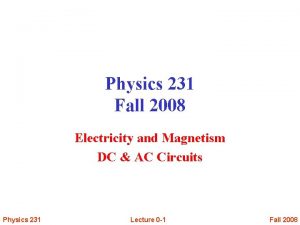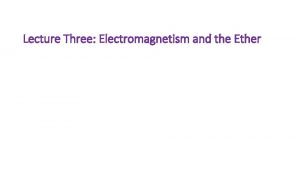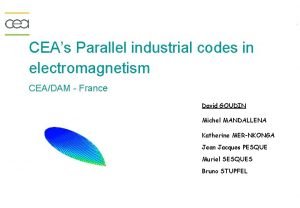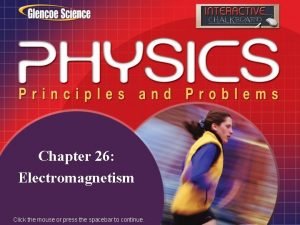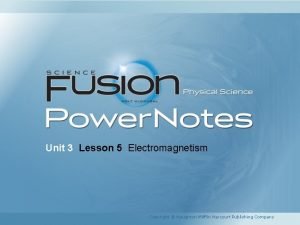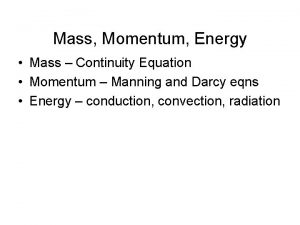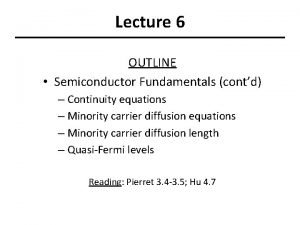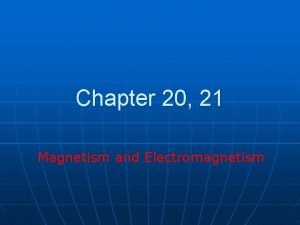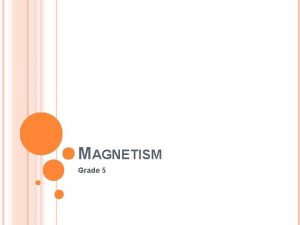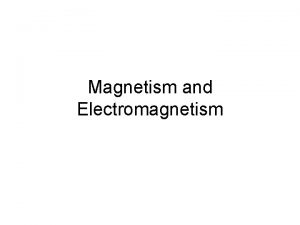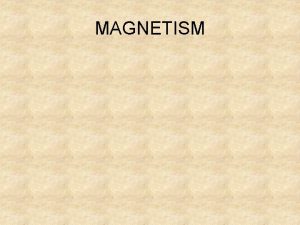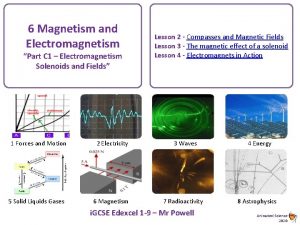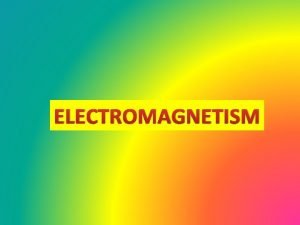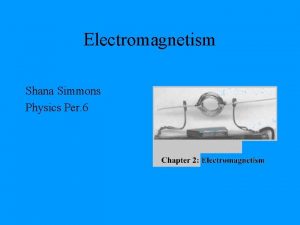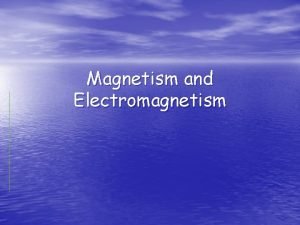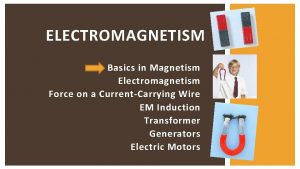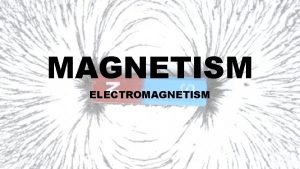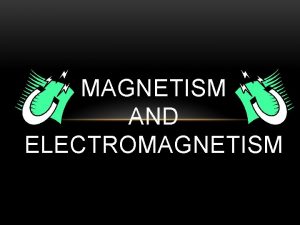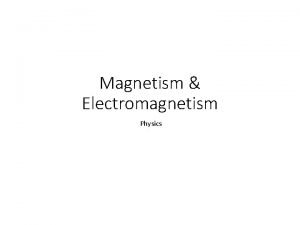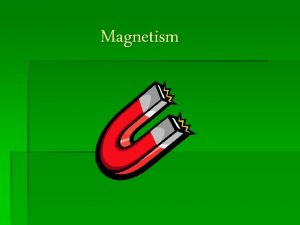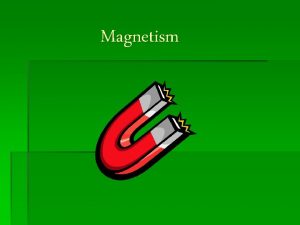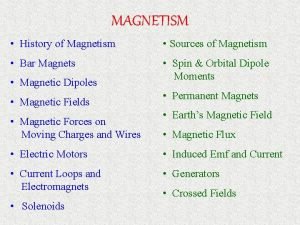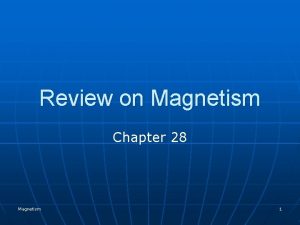6 Magnetism and Electromagnetism Part C 2 Electromagnetism































- Slides: 31

6 Magnetism and Electromagnetism “Part C 2 – Electromagnetism Solenoids and Fields” 1 Forces and Motion 5 Solid Liquids Gases 2 Electricity 6 Magnetism Lesson 5 - Calculating force on a wire Lesson 6 - Electric motors Lesson 7 - Loudspeakers 3 Waves 7 Radioactivity i. GCSE Edexcel 1 -9 – Mr Powell 4 Energy 8 Astrophysics Animated Science 2020

6 Electromagnetism “Part C - 1 and 2” 6. 11 P know that there is a force on a charged particle when it moves in a magnetic field as long as its motion is not parallel to the field (Triple) 6. 12 understand why a force is exerted on a current-carrying wire in a magnetic field, and how this effect is applied in simple d. c. electric motors and loudspeakers. 6. 13 use the left-hand rule to predict the direction of the resulting force when a wire carries a current perpendicular to a magnetic field. 6. 14 describe how the force on a current-carrying conductor in a magnetic field increases with the magnitude and direction of the field and current. Animated Science 2020

Animated Science 2020 Mr D Powell 2020 Lesson 5 Calculating the force on a conductor (1 hour) (Triple) - EXTENSION N I can explain the meaning of magnetic flux density, B. 4 B S I N S I can know the factors that make a more powerful motor. 5/6 7/8 I can calculate the force on a current-carrying conductor in a magnetic field using graphical methods. (Formulae version is extension but useful!) I can make up my own problems looking at F = BIL with realistic values (Extension) Animated Science 2020

Magnetic Fields – Key Ideas 1. When we measure magnetic fields we have a variable called the magnetic flux density B 2. It is measured in Newton per meters per ampere (N/m. A OR Nm-1 A-1, also called teslas (T). 3. A magnetic field can be visualised as magnetic field lines and the field strength corresponds to the density of the field lines. 4. The total number of magnetic field lines penetrating an area is called the magnetic flux. 5. Magnetic flux density (B) diminishes with increasing distance from a wire carrying a current. Think about a previous practical with the kicking wire. Using the information here, how can you link the formulae as shown, and the information in the panels. Be prepared to discuss… F = BIL F = force on the wire (measured in N) B = magnetic flux density (measured in T) I = current (measured in A) L = length of the wire (measured in m) Animated Science 2020

Definition: Magnetic Fields 1. When we measure magnetic fields we have a variable called the magnetic flux density B 2. It is measured in Newton per meters per ampere (N/m. A OR Nm-1 A-1, also called teslas (T). 3. A magnetic field can be visualised as magnetic field lines and the field strength corresponds to the density of the field lines. 4. The total number of magnetic field lines penetrating an area is called the magnetic flux. 5. Magnetic flux density diminishes with increasing distance from a wire carrying a current. F = BIL F= force on the wire (measured in N) B = magnetic flux density (measured in T) I= current (measured in A) L= length of the wire (measured in m)

Lesson 5 Force on a Conductor - Worksheet 1. When we measure magnetic fields we have a variable called the magnetic flux density B 2. It is measured in Newton per meters per ampere (N/m. A OR Nm-1 A-1, also called teslas (T). (extension) 3. A magnetic field can be visualised as magnetic field lines and the field strength corresponds to the density of the field lines. 4. The total number of magnetic field lines penetrating an area is called the magnetic flux. 5. Magnetic flux density diminishes with increasing distance from a wire carrying a current. F = BIL F = force on the wire (in N) B B = magnetic flux density (in T) N S I I = current (in A) L = length of the wire(in m) NB: The ideas of F = BIL are used in i. GCSE but not directly tested as “recall” Animated Science 2020

Lesson 5 Force on a Conductor – Worksheet – Answers…. 2 a The force doubles. 2 b The force is four times bigger. 3 a F = BIl = 0. 05 × 0. 5 × 2 = 0. 05 N 3 b F = BIl = 0. 1 × 2 × 0. 5 = 0. 1 N 4 I = F / Bl = 0. 03 / (0. 02 × 0. 3) = 5 A along the wire. 1 The magnetic field inside the solenoid is uniform (the same everywhere). This can be seen by the field lines that are parallel and equally spaced. The strength of the field is indicated by how close the lines are together and they remain the Animated Science same distance apart throughout. 2020

Lesson 5 Force on a Conductor – Worksheet – Answers…. 5 B = F / Il = 0. 05 / (3 × 0. 25) = 0. 067 T 6 No. When the length of wire is parallel to the magnetic field then no force acts; a maximum force acts when they are at right angles to each other. 7 a Force needed to lift wire = 0. 30 N F = BIl So 0. 30 = 0. 00003 × I × 2. 0 I = 0. 30 / (0. 00003 × 2. 0) = 5000 A. 7 b No, it wouldn’t be possible. The magnetic field lines near a pole would be vertical. The force needs to be at right angles to the field lines (from Fleming’s left hand rule) so there is no orientation of the wire that can produce a force upwards. Animated Science 2020

Lesson 5 Calculating the force on a conductor 1) Calculate the missing values using F = BIL (Medium Challenge) Force (N) 0. 15 0. 02 0. 03 Current (A) Length of wire (m) 2 0. 25 5 0. 50 0. 10 10 2 6 0. 20 0. 50 L Magnetic flux density (T) 0. 20 0. 15 0. 02 0. 01 2) Calculate the missing values…. (Medium Challenge) Length of wire (m) Force on wire 1 / N B = 0. 01 T I=5 A Force on wire 2 / N B = 0. 02 T I=5 A Force on wire 3 / N B = 0. 1 T I=2 A 1 0. 05 0. 10 0. 20 2 0. 10 0. 20 0. 40 3 0. 15 4 5 6 3) Using the table above create a graph of Force v Length of the wire and plot all three sets of data on axis set. …. (Harder Challenge) 4) Comment on the relationships you can see. (Medium Challenge) Use proper graph paper! Hint: Q 2 has three situations where B, I, L vary, you have to fill the gaps 5) Work out the gradient / formula for each one and compare! Animated Science 2020

Lesson 5 Answers… to data…. . 1) Calculate the missing values using F = BIL (Medium Challenge) Force (N) 0. 10 L Current (A) Length of wire (m) 2 0. 25 Magnetic flux density (T) 0. 20 0. 25 5 0. 50 0. 15 10 0. 15 0. 05 10 0. 25 0. 02 2 0. 20 0. 05 0. 03 6 0. 50 0. 01 1, 4 2) Calculate the missing values…. (Medium Challenge) 1, 2 Force on wire 1 / N B = 0. 01 T I=5 A Force on wire 2 / N B = 0. 02 T I=5 A Force on wire 3 / N B = 0. 1 T I=2 A 1 3 0. 05 0. 10 0. 15 0. 10 0. 20 0. 30 0. 20 0. 40 0. 60 4 0. 20 0. 40 0. 80 5 0. 25 0. 50 1. 00 6 0. 30 0. 60 1. 20 3) Using the table above create a graph of Force v Length of the wire and plot all three sets of data on axis set. …. (Harder Challenge) 4) Comment on the relationships you can see. (Medium Challenge) 1 Force /N Length of wire (m) 2 R 2 = 1 0, 8 R 2 = 1 0, 6 R 2 = 1 0, 4 0, 2 0 0 2 Length /m 4 6 Hint: Q 2 has three situations where B, I, L vary, you have to fill the gaps 5) Work out the gradient / formula for each one and compare! Animated Science 2020

Lesson 5 Calculating the force on a conductor Force Current (A) Length of wire (m) (N) 0. 10 2 0. 25 5 0. 50 0. 15 10 0. 05 10 0. 25 0. 02 2 0. 20 0. 03 6 0. 50 Magnetic flux density (T) 0. 20 0. 15 0. 02 0. 05 0. 01 Length of wire (m) Force on wire 1 / N B = 0. 01 T I=5 A Force on wire 2 / N B = 0. 02 T I=5 A Force on wire 3 / N B = 0. 1 T I=2 A 1 2 3 0. 05 0. 10 0. 15 0. 10 0. 20 0. 30 0. 20 0. 40 0. 60 4 0. 20 0. 40 0. 80 5 0. 25 0. 50 1. 00 6 0. 30 0. 60 1. 20 Animated Science 2020

Results…. . GRAPH TO SHOW THE FORCES CHANGE ON A CURRENT CARRYING WIRE Using the graph enables you to compare the BI. The one with more BI is the one with more force which is the gradient of the graph. 1, 2 R 2 = 1 1 Force /N Formulae is. . 1, 4 0, 8 R 2 = 1 0, 6 0, 4 F = BI*L R 2 = 1 0, 2 0 0 Y = m*x+c Length of wire (m) 1 2 3 4 5 6 Force on wire 1 / N B = 0. 01 T / I = 5 A 0. 05 0. 10 0. 15 0. 20 0. 25 0. 30 2 Force on wire 2 / N B = 0. 02 T / I = 5 A 0. 10 0. 20 0. 30 0. 40 0. 50 0. 60 4 Length /m 6 Force on wire 3 / N B = 0. 1 T / I = 2 A 0. 20 0. 40 0. 60 0. 80 1. 00 Animated Science 1. 20 2020 8

Plenary / Review Task… Using the formula F = BIL imagine you have three out of the 4 variables, if you check it on your calculator can you rearrange and get the correct answers each time… Given values are… Force = 0. 1 N Magnetic flux density = 0. 03 T Current = 2. 5 A Length of wire = 1. 2 m Force = ? Magnetic flux density = ? Current = ? Length of wire = ? Animated Science 2020

Extension Practice Questions… L Task… Using the formula F = BIL clearly you have three out of the 4 variables, what is missing? Force (N) Current I (A) 2. 0 0. 125 0. 0600 0. 075 0. 150 0. 080 0. 100 1. 5 3. 0 4. 0 2. 5 Length of wire (m) 10 40 60 25 5 100 Magnetic flux density B (T) 3. 0 × 10 -4 2. 0 × 10 -3 1. 5 × 10 -2 8. 0 × 10 -4 Force Current Length of Magnetic flux (N) (A) wire (m) density (T) 0. 006 0. 125 0. 060 0. 075 0. 150 0. 080 0. 100 2. 0 1. 6 1. 5 3. 0 4. 0 2. 5 10 40 20 60 25 5 50 100 3. 0 × 10 -4 2. 0 × 10 -3 6. 3 × 10 -4 1. 5 × 10 -3 1. 5 × 10 -2 8. 0 × 10 -4 4. 0 × 10 -4 Animated Science 2020

Animated Science 2020 Mr D Powell 2020 Lesson 6 Electric motors (1 hour) – p 312 I can list equipment that uses motors. 4 5/6 7/8 I can describe how motors work applying Flemings Left hand rule AND I can describe how to change the speed and direction of rotation of a motor. I can compare a DC and AC motor using a source of information. (extended writing) I can explain in detail now the current flow changes on AC and DC motor. Animated Science 2020

Modelling / Understanding Motors – Video…. The magnetic field produced by the electric current interacts with the magnetic field produced by the magnets. https: //www. youtube. co m/watch? v=o. DBf. Ya. Zvp_I This creates forces on a coil of wire which push one side up and the other side down. These forces turn the coil. However, some motors are run on A. C. using “slip rings” and some on D. C. using a “split-ring commutator” NB: AC motors are not required for i. GCSE Animated Science 2020

Lesson 6 Electric Motors – Explained with Questions… Electric motors have many uses around the home. Any electrical machine that has moving parts is likely to have a motor. For example, an electric lawn mower, a food processor and an electric drill all contain electric motors. When a current passes through a coil placed between the poles of a magnet there is a force on each side of the coil Fleming's left hand rule shows that the forces on each side of the coil are in opposite directions, so the coil will move. One side of the coil moves up and the other side moves down. This makes the coil start to spin. A direct current (d. c ) motor has a splitring commutator that rotates with the coil between two carbon brushes. The commutator allows the motor to continue to spin without reversing direction every time it gets to the vertical position. Questions… 1. Why does the coil start to spin? 2. Explain how a split-ring commutator works. 3. What effect would there be if both the current and magnetic field were reversed? 4. Give two things that could be done to make the motor turn at a slower speed? 5. Suggest why you could not use wires to connect the coil of the motor without a commutator? 6. In more practical motors the coil is often wound round some iron. Explain what advantage this gives? You can use Fleming's left-hand rule to work out the direction of the force. On the left hand side of the coil the direction of the current is towards the commutator and the field is to the right so the force is upwards. On the right hand side of the coil things are reversed so the coil spins clockwise. When the coil is vertical, the circuit is broken and no current flows but since the coil is moving, there is enough momentum for the coil to carry on rotating a little further. Practical motors have curved pole pieces This produces a radial field at right angles to the motion of the coil. This increases the force and keeps it constant as the rod turns. Animated Science 2020

Lesson 6 Electric Motors – Explained with Questions… 1. Why does the coil start to spin? 2. Explain how a split-ring commutator works. 3. What effect would there be if both the current and magnetic field were reversed? 4. Give three things that could be done to make the motor turn at a slower speed? 5. Suggest why you could not use wires to connect the coil of the motor without a commutator? 6. In more practical motors the coil is often wound round some iron. Explain what advantage this gives? Answers…. 1. The magnetic field produced by the electric current interacts with the magnetic field produced by the magnets. This creates forces on the coil which push one side up and the other side down. These forces turn the coil. 2. The commutator connects the coil to the power supply. However, the connections swap to the other side of the coil every time the coil makes half a turn. This ensures that the direction of the current is correct for the forces to continue to spin the coil in the same direction. 3. They would cancel each other out. 4. Reduce the current / Reduce the strength of the magnetic field / Reduce the number of turns on the coil. 5. As the coil rotates, the wires would become all tangled up so you must have a brush or ring system. 6. The iron will magnetise with the same shape as the magnetic field that is present. This makes the magnetic field much stronger and therefore the motor will turn faster. Animated Science 2020

Lesson 6 Electric motors AC v DC motors, a Comparison… The magnetic field produced by the electric current interacts with the magnetic field produced by the magnets. This creates forces on the coil which push one side up and the other side down. These forces turn the coil. The commutator connects the coil to the power supply with carbon brushes and split rings. However, the connections swap to the other side of the coil every time the coil makes half a turn. This ensures that the direction of the current is correct for the forces to continue to spin the coil in the same direction. (Opposing Forces) The slip ring allows a similar situation where the forces are always up on one side and down on the other even though the current alternates. (AC at 50 Hz) The slip rings allow the transmission of electrical energy without tangling the wires. Animated Science NB: AC motors are not required for 2020 i. GCSE

Waves Review Task. . Look at each wave diagram and imagine you were that particle. . Soundwave - Longitudinal What would you feel in terms of… 1. Motion 2. Speed Mechanical wave - Transverse 3. Forces? 4. What key Scientific terms might you use? Animated Science 2020

Animated Science 2020 Mr D Powell 2020 Lesson 7 Loudspeakers (1 hour) – page 313 4 5/6 7/8 I can link the vibration on a loudspeaker to the properties of the waves it produces. I can describe how a sound wave travels AND the basics of how a moving coil loudspeaker works. I can compare loudspeakers and headphones and explain how they work. I can explain how the field and current interactions inside a magnet make the motion and link to Flemings LHR and FBI Animated Science 2020

How is Sound heard. . . The outer ear collects sound (green). The sound is amplified through the middle ear (red) which is hollow, and filled with liquid, containing a sensory epithelium that is studded with hair cells. The tiny "hairs" from the cells stick out into the fluid. The hair cells release a chemical neurotransmitter when stimulated. In this way sound waves are transformed into nerve impulses. (purple) The nerve impulses travel to both sides of the brain with the vestibular nerve dealing with sensing balance. The human ear can generally hear sounds with frequencies between 20 Hz and 20 k. Hz (the audio range). Animated Science 2020

Lesson 7 Loudspeakers Woofers, tweeters and mid-range speakers are types of loudspeakers which sound different because they reproduce different frequencies of sound. A sound wave is a series of oscillations or vibrations that travel in the same direction as the direction of the oscillations - they are longitudinal waves. The vibrations travel through the air as pressure waves and transfer energy. A moving-coil loudspeaker has a permanent magnet and an electromagnet. The magnet is fixed and the cod of the electromagnet can move backwards and forwards. The coil is attached to the cone (usually paper or plastic) of the loudspeaker. The outer edge of the cone is fixed and does not move. A cylindrical magnet produces a strong radial magnetic field. This is at right angles to the wire in the coil. A change in the current in the coil causes a change in the magnetic force acting on the coil. The changing force causes the coil to move in and out. As the current varies, the coil moves. As the coil is attached to the cone, the cone also moves, setting up vibrations in the air. The current flowing in the coil of the loudspeaker causes changes in pressure in the air around the loudspeaker. Energy is transferred from the loudspeaker to the air, making the particles move. Headphones and speakers are the same thing but on a different scale. Vibration +A/-A Wave direction Lower Freq Louder Sound Higher Freq Quieter Sound Animated Science 2020

Lesson 7 Loudspeakers Review Questions. . 1. How are sound waves produced? 2. Explain how an alternating current can make the loudspeaker cone vibrate? 3. Two loudspeakers are connected to the same current However, why does one speaker produce a louder sound than the other? Vibration +A/-A Answers… 1. Sound waves are produced by vibrating objects, which in turn make the air vibrate as a longitudinal wave. 2. The alternating current keeps changing direction. This produces a force on the loudspeaker cone which keeps changing direction – so the loudspeaker cone vibrates. 3. The louder speaker could have more turns in its coil and/or it could be using a stronger magnet. Also the coil might be made of lighter wire so it can move more easily. Wave direction Lower Freq Louder Sound Higher Freq Quieter Sound Animated Science 2020

Lesson 7 Loudspeakers – Review Questions 2 a) Where should the missing labels go… 1. 2. 3. 4. 5. Current Coil of Wire Magnet Diaphragm Frame d) e) b) c) f) Answers… Current - a/c Coil of Wire – e Magnet - b Diaphragm - d Frame - f Animated Science 2020

Lesson 7 Loudspeakers – Sequencing Question Can you put these in the correct order from 1 to 5? Write down the order… 1) 2) 3) 4) 5) a) The current flows through the coil. b) The movement of the diaphragm moves the air particles so that sound waves are produced. Answers… c) An electrical signal is generated, 1) c 2) a 3) e 4) d 5) b d) The coil is attached to the diaphragm, so the force moves the diaphragm. e) Since the coil is in a magnetic field, this generates a force. Animated Science 2020

Lesson 7 Loudspeakers – Labelling Waves A B A B A Questions? Use the diagrams… 1. Where are the compressions? 2. Where are the rarefactions? 3. What is a wavelength λ on the diagram? 4. Describe the meaning of “amplitude” for a particle at point “X” 5. What is the direction of the energy of the wave? X Answers… 1. All the points marked A – particles are close together “compressed” 2. B – same reason but spaced apart 3. From A to A or comp -> comp 4. The amplitude is how far a particle at “X” moves back and fourth. The more energy the wave has the larger the motion. 5. Away from the speaker Animated Science 2020

Lesson 7 Loudspeakers – Sequencing Question – Higher Level Science/ Eng Version 1. 2. 3. 4. 5. 6. 7. 8. 9. 10. The current in the electrical circuit is varying The current passes through the coil The coil experiences a force (inwards or outwards) Reversing the current reverses the force The size of the current affects the size of the force The varying current causes the coil to vibrate The (vibrating) coil causes the cone to vibrate The vibrating cone causes the air molecules to move The movement of the air molecules produces the pressure variations in the air needed for a sound wave The air molecules bunch together forming compressions and spread apart forming rarefactions Animated Science 2020

Worksheet Answers Q 4…. c, d a, b A e c = const f) The frequency in the new diagram would be twice as big as the frequency in the first diagram. c = f c = 2 f* /2 g) The second sound wave would have a higher pitch. h) The speaker with the wave that you have drawn would vibrate twice as fast. (more frequent!) Animated Science 2020

Spaced Learning Review Question Task 1… Answer the questions on your own – write a clear answer and number in your book. Get as far as you can in the time you have…. Motors and Speakers Animated Science 2020

Spaced Learning Review Answers Task 2… Mark your work in green pen, you can judge how you did, put a clear total at the bottom and put one clear comment on what you must improve on. Motors and Speakers Animated Science 2020
 Magnetism and electromagnetism
Magnetism and electromagnetism Magnetism and electromagnetism
Magnetism and electromagnetism Scrap yard magnet how it works
Scrap yard magnet how it works Magnetism and electromagnetism
Magnetism and electromagnetism Electromagnetism uses
Electromagnetism uses Electromagnetism grade 12
Electromagnetism grade 12 Ap physics 2 electromagnetism
Ap physics 2 electromagnetism Em force equation
Em force equation Electromagnetism
Electromagnetism Electromagnetism
Electromagnetism Electromagnetism
Electromagnetism Electromagnetism cheat sheet
Electromagnetism cheat sheet Electromagnetism
Electromagnetism Ceadam
Ceadam Diode khan academy
Diode khan academy Equation de conservation de charge
Equation de conservation de charge Chapter 26 electromagnetism study guide answers
Chapter 26 electromagnetism study guide answers Electromagnetism
Electromagnetism Lesson 5 electromagnetism answer key
Lesson 5 electromagnetism answer key Equation of continuity
Equation of continuity Derive equation of continuity
Derive equation of continuity Attenuation constant formula
Attenuation constant formula Hans christian oersted electromagnetism
Hans christian oersted electromagnetism Methernitha testatika
Methernitha testatika 4 forces of nature
4 forces of nature Ib physics topic 5 questions and answers
Ib physics topic 5 questions and answers Magnetism
Magnetism Electricity jeopardy
Electricity jeopardy Sph3u electricity and magnetism
Sph3u electricity and magnetism Electromagnet experiment hypothesis
Electromagnet experiment hypothesis Magnetic susceptibility formula
Magnetic susceptibility formula Magnetism grade 5
Magnetism grade 5
